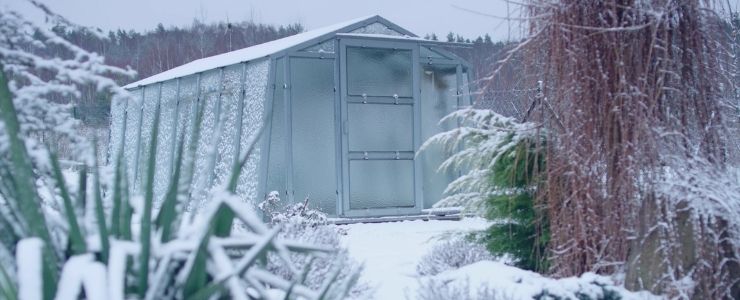When most people think of greenhouses, they think of plants flowering in the spring and summer. But did you know that greenhouses can also be used in the winter? Greenhouses provide a space for plants to grow, regardless of the outdoor temperature. While greenhouses are typically used in the summer to extend the growing season, they can also be used in winter. In fact, a greenhouse can provide an ideal environment for plants to grow during the colder months. So, does a greenhouse work in the winter?
Heated and unheated greenhouses can still be used during the cold winter months. While the temperature inside may be a little colder than usual, the plants will still be able to grow with the right care. Make sure to water them regularly and monitor the climate closely so that they don’t get too cold or too hot.
If you are interested in knowing more about growing in a greenhouse through winter, the heating and what to grow, then keep reading to learn more.
- Can greenhouses be used in winter
- How cold is too cold for a greenhouse?
- Do you need to heat a greenhouse in the winter?
- How do you keep plants alive in a greenhouse in the winter?
- Do greenhouses still work in very cold climates?
- How Can I Heat My Greenhouse In The Winter?
- What is the cheapest way to heat a greenhouse during winter?
- Plants to Grow in a Winter Greenhouse
- All in All
Can greenhouses be used in winter
Yes, greenhouses can be used in winter. In fact, many people use greenhouses in winter to extend the growing season for plants. Greenhouses work by trapping heat from the sun and then using that heat to warm the air inside the greenhouse. This heated air then circulates around the plants, warming them and helping them to grow.
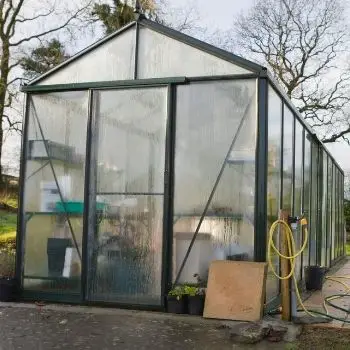
Greenhouses can be used in winter to grow plants that wouldn’t normally be able to grow in cold weather. For example, it’s very possible to grow tomatoes in winter, but for that to happen it will come with some serious additional heating costs.
How cold is too cold for a greenhouse?
The coldest a greenhouse should go to will determine the crops it has. If the crops fall into the “Cold-tolerant plants” then the lowest base temperature where the crops will no longer grow would be around 39 degrees Fahrenheit (4°C).
Different plants grow and thrive best in different temperatures. There are generally three different optimal growing conditions, they are called cardinal temperatures.
For optimal growing conditions, you will need to arrange your plants into their cardinal temperatures.
- Cold-tolerant plants – These plants have a base temperature of around 39 degrees Fahrenheit | 4 degrees Celsius
- Cold-temperate plants These plants have a base temperature of between 40 – 45 degrees Fahrenheit | 4-7 degrees Celsius
- Cold-sensitive plants – These plants have a base temperature of around 46 degrees Fahrenheit | 8 degrees Celsius
The minimum temperature at which a plant will no longer grow is known as the base temperature. It’s the maximum (or minimal) temperature that a plant can tolerate before stopping growth.
When determining how cold is too cold for a greenhouse, you will need to know the base temperature of your crops. It’s this temperature that needs to be met otherwise your crops won’t grow.
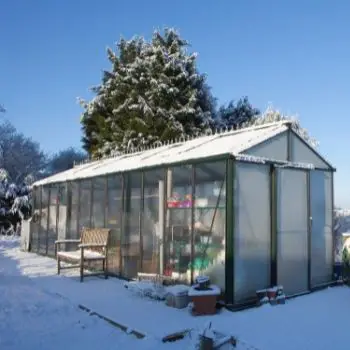
At the base temperature, your crop will grow at its slowest rate, or not at all. At the optimum temperature, between 70 and 90 degrees Fahrenheit, crops will grow at their fastest rate. the optimum temperature is the best growing condition to achieve
39 degrees Fahrenheit would be too considered too cold for most crops in a greenhouse.
Do you need to heat a greenhouse in the winter?
Heating a greenhouse in the winter will help keep the plants inside healthy and thriving, but it’s not absolutely necessary. If you live in an area with cold winters, you may need to take some extra steps to keep your greenhouse warm.
Some of the ways of doing this are by using heating mats, installing a greenhouse heater, or using bubble wrap or insulation to keep the heat in.
If your greenhouse becomes too cold, your plants, vegetables, and herbs won’t grow.
How do you keep plants alive in a greenhouse in the winter?
One way to keep plants alive in a greenhouse in the winter is by using grow lights. Grow lights emit light in the visible spectrum, which helps plants to photosynthesize.
Another way to keep plants alive in a greenhouse in the winter is by using a humidifier. A humidifier increases the humidity of the air, which helps plants to retain water.
Finally, you can keep plants alive in a greenhouse in the winter by using a heater. A heater increases the temperature of the air, which helps plants to grow.
Do greenhouses still work in very cold climates?
Greenhouses work in cold climates as long as they are properly insulated. In very cold climates, it may be necessary to add extra insulation to the greenhouse in order to keep the plants warm. Greenhouses can also use special heating systems to help keep the plants warm.
Related article:
How Can I Heat My Greenhouse In The Winter?
We have been looking at, does a greenhouse work in the winter? And we have learned that it certainly does! But, If you want to keep your greenhouse warm in the winter, there are a few things you can do.
One option is to use a greenhouse heater. These heaters come in a variety of sizes, so you can find one that will fit your greenhouse. The problem with this is they use up a lot of electricity. Even on a solar panel system, you will struggle to support an electric space heater for hours every day.
Another option is to insulate your greenhouse. This will help keep the heat inside and reduce the amount of heat that escapes. You can buy insulation for greenhouses, or you can make your own.
Gas heaters can also be used in greenhouses, gas heaters work out cheaper to run and maintain than electric.
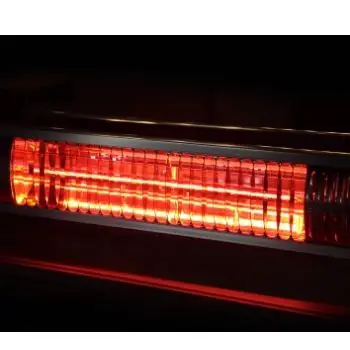
Another option is to use a greenhouse heater combined with insulation. This is the best option if you want to keep your greenhouse warm in the winter. The heater will help keep the greenhouse warm, and the insulation will keep the heat from escaping.
What is the cheapest way to heat a greenhouse during winter?
There are a few different ways to heat a greenhouse during winter cheaply or even for free. Here are three simple and easy ways:
Use the sun: The sun is a free and abundant source of heat, so take advantage of it! Make sure your greenhouse is located in an area that gets plenty of sunlight, and Insulate your greenhouse well to keep the heat in.
Store thermal energy: Thermal energy can be stored in water, soil, or rocks, and then used to heat your greenhouse when needed. Setting up a solar thermal system is a great way to take advantage of this renewable energy source.
Use compost heat: Composting is a great way to heat your greenhouse for free! The decomposing organic matter releases heat, which can be used to warm your greenhouse. Make sure to use a well-insulated composter to get the most out of this method.
Plants to Grow in a Winter Greenhouse
If you’re planning on growing in a greenhouse with less insulation and no heating system, you might just have to accept that things will get a little cold on those chillier nights. But that shouldn’t stop you.
Related article:
Avid gardeners may be familiar with the concept of the grow-box. These boxes, built from glass and wood, mimic high-quality greenhouses with all their insulation tricks. A DIY home greenhouse is more like a hoop tunnel.
Hoop tunnels are a strategy for winter growers that utilize minimal resources for high returns. The basic premise is this- protect from frost, and that’s all. Growing vegetables in these simple contraptions just require that you pick the right plants. Winter growing in your plastic-and-toothpick claptrap is just the same.
While you may not be able to keep it summery in your greenhouse, you can still guard your plants against frost. With this advantage, there are plenty of plants that will grow throughout the winter.
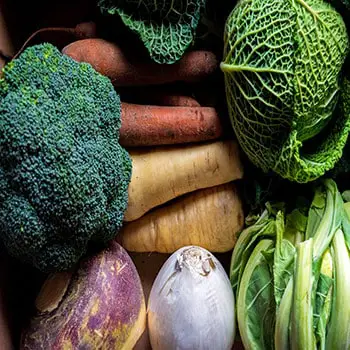
Carrots
Who doesn’t love a good carrot? Whether steamed, mashed, cooked into a soup, or eaten raw, carrots are a great source of nutrients that always delight. But what most people don’t know about carrots is that they’re incredibly hardy little plants.
Your average carrot can actually withstand temperatures as low as 15 degrees Fahrenheit. That makes them the Rocky Balboa of the gardening world. Keep the frost off these babies, and you’ll be eating garden-fresh veggies year-round.
Spinach
Spinach is great in dips, salads, and even smoothies, and bags of spinach fly off the shelves at grocery stores every single day. With their soft, leafy texture, you wouldn’t expect them to be as hardy as they are- but oh, they are.
Spinach can withstand the low temperatures of winter and is used by winter gardeners across the world to keep fresh vegetables flowing through the door despite cold temperatures. If you’ve got a craving for a garden-fresh crunch, try planting a few spinach plants. You won’t regret it.
Radish
The jury is far from out on radishes. Some think they’re a delightful addition to a salad and will eat them pickled as well as baked. Others won’t go anywhere near them. It’s true- that spicy kick can be a limiting factor in their popularity- but who can blame them? They can go through a lot in their little lives and still be edible and delicious.
Radishes- the ugly little tubers with an attitude- can withstand soil temperatures as low as 40 degrees! Keep the frost off their leaves, and they’ll be growing like champs all winter long. There’s nothing you can’t do with a good row of radishes in your winter greenhouse.
Garlic
I have some personal memories with garlic- and no, not culinary ones. Some people may remember garlic as the little minced jelly you pull out of a jar. I remember it as the hardy crop that my uncle would grow in his garden all winter long.
If you’re looking for a vegetable that will stick out the cold temperatures with you, you’re looking for garlic. A clove or two of garlic is an excellent addition to a steak, a soup, or any culinary creation under the sun- and fresh garlic is all the better for really picky chefs.
Peas
Good lord, do we love peas. Just the thought of that crunchy snap as you bite into a fresh pea is enough to make the mouth water. But, like our other selections, these cute little veggies have a tough side.
While peas may not look as brutal as, say, carrots or radishes, you shouldn’t underestimate their ability to stick out a cold night. So long as you don’t let the frost get to them, you’ll be eating crunchy green peas whenever you want- rain or shine, wind or frost.
Just save some for everyone else- that crunch can get just a tad addicting.
Broccoli
For our final recommendation- why not try growing a bit of broccoli? Broccoli will stick it out in the colder weather and will grow just fine in less-outfitted greenhouses. Plus, a broccoli-cheddar stew never hurt anyone.
All in All
So, does a greenhouse work in the winter? The answer is yes! With a little bit of extra care, your plants will be able to thrive even when the temperature outside is below freezing. Just be sure to water them regularly and monitor the climate closely so that they don’t get too cold or too hot. And if you have any questions about keeping your greenhouse going during the winter months, don’t hesitate to reach out to us. We’re happy to help!

